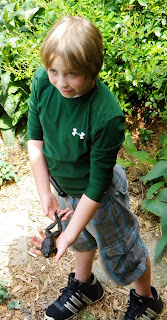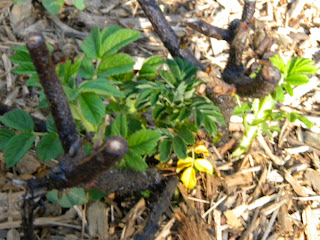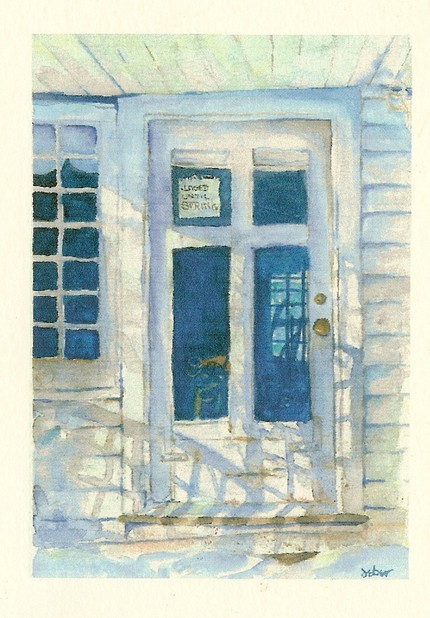My most recent mystery roses have bloomed, at last. I must say, even the ones that I thought I knew turned out to be mysteries. But my favorite and most anticipated, the Rosa Rugosa, bloomed today. She has not disappointed me. She is pink and semi-double, with a fluffy yellow center. I'm very happy with her.
We've had a lot of rain this spring. I'm not complaining, mind you, because who in their right mind (and I always am) would complain about something as good as rain? But not only is this wonderful, abundant rain causing blackspot on most of my roses, it is also giving the weeds a strong foothold along the walk.
However, weeding can become a fun hunt for freebies.
For example, the Johnny Jump-ups that I planted in a pot last fall have gone to seed, and all kinds of Johnnies are coming up in the walkway.
Note: If I am not able to put them in the planting beds before a few days, I will put them in a large pot of potting soil, watering them well and keeping them in part shade until I am able to get them in the ground. They won't last long this way.
Our herbs are growing fabulously this year. I know what some of you are thinking. Herbs are weeds, so if the weeds are happy, the herbs are, too. Not necessarilary true, my friend. But for those of you who know how magnificent an herb plant can be in the garden, here are some easy to grow, useful and beautiful herbs:
Normally, Echinacea is a soft violet pink color, but I found these at Home Depot this weekend. I thought I'd died and gon to heaven, but thank goodness, it's just a new hybrid!
I'm going to plant them next to something blue that is also blooming this time of year, so the blooms will complement each other.
Echinacea is a medicinal herb used for asthma and other lung ailments. But it is known to raise bloodpressure. As an asthmatic (since I was four), I can assure you that the new medicines for asthma far exceed any benefits you can get from Echinacea. I grow it for it's beauty only.
Russian Comfrey has a gorgeous blue flower.
Most comfrey plants I've seen have a pink/purple flower. Comfrey makes a poltice to put on infection. Again, though I know people who use it, I never have. It's a beautiful plant. A friend gave me three tiny sprouts about 15 years ago, and they've tried to take over the garden ever sense. I just pull them up if they come up where I don't want them. Over and over and over and over, all summer. These gorgeous Periwinkle blooms are worth it, however.
Speaking of Periwinkle Blue blossoms, Borage is an herb with edible flowers. Not only are they pretty on a salad, they taste like cucumber. I have read that you can add the leaves to salad, but I've only eaten the flowers. You can toss them on your salad with Violets and Nasturtiums. Gorgeous, healthy, and delicious!
Though it's not an herb, there are still a few stray blooms of Bleeding Heart peeking over the Peonies at the back of the border. This girl is over 4 feet tall. I planted her many years ago.
Pineapple Sage is a delightful smelling herb used for making teas. This one was planted this year and is already quite large. I usually grow Pineapple Sage as an annual in this climate, but many years it does survive the North Carolina Piedmont's winter. After buying a new one this year, I realized that last year's plant had shown her pretty head once again. (After all, we'd had snow all winter, which protects many plants from the bitter cold.) As you see, Pineapple Sage has red trumpet shaped blooms on spikes at the end of each branch. This is the first bloom this year.
I found the cat in the garden the other day, laying contentedly on his back. Actually, at first sight, I was afraid he was sick. Then I saw this Catnip had sprung up along the garden path...it came up from seed. So El Cat-o wasn't sick. He was just happy.
Catnip not only delights your kitten, it makes a relaxing tea, but it's good for respiratory infections and asthma, tummy troubles, and many other things. (read more about it here: http://www.herbs2000.com/herbs/herbs_catnip.htm)
Mr. and Mrs. Birdie have decided to build a next in the Brown Turkey Fig that grows well on the southeast side of the house. I hope that's a good idea. The hornets and bees love that fig tree come August. So do I, but I don't like the bees and the hornets, so I miss most of the fig season due to bugs. My sis Jeanie is taking allergy shots for stinging insects. I'm going to look into it.
Being allergic to bees is hard on a gardener.
The Kimberly Fern is, in my opinion, the best fern for the front porch pot. I prefer it over the Boston fern any time. Not only does it not drop its leaves like the Boston does, but it can handle the cold and the heat better. Let it dry out between waterings. If it likes where and how you keep it, it will get really large, with fronds that grow long and lush. If planted in the deep South, it may escape into the garden and become a pest (if you can consider ferns in the garden pesky...). Up here in North Carolina,
I don't think that's anything to worry about.
Last but not least, my darling, Rainy Spring days are perfect days for setting the
hanging orchids out on the stoop. I watered the ones in pots, but these Vandas can get messy when watered, because the Orchid Mix falls all over everything, and water can't be contained. I usually water them in a large bowl, but on this rainy day, I happily set them on the porch; and they were glad to be there.
That's it, honey-bun. Just some garden thoughts and pictures for you today. See ya' next time.
deber













































